Measurement of the proton Electric Dipole Moment (EDM)
Measurement of the proton Electric Dipole Moment (EDM)
| Research Group |
| Prof. Paolo Lenisa |
| Dr. Luca Barion |
| Nicola Canale |
| Prof. Giuseppe Ciullo |
| Dr. Marco Contalbrigo |
| Dr. Andrea Pesce |
The mystery of matter in the Universe
Why are we made of matter (and not of antimatter)?
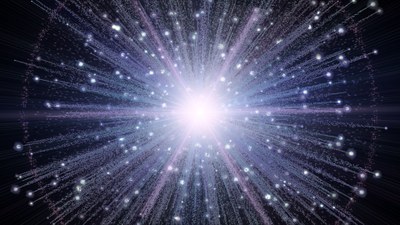
According to the Big Bang Theory, which describes the evolution of the universe since the first moments after its birth, in origin matter and antimatter were equally abundant. Afterwards, the universe went from its initial symmetric condition to its actual state of dominance of matter on antimatter. This process is called baryogenesis.
The criteria describing this process were formulated in 1967 by the soviet scientist Andrej Sakharov, and include mechanisms that violate the C symmetry (charge conjugation) and the combined CP symmetry (charge conjugation and parity). In particular, the CP asymmetry is the one telling us that matter and antimatter don’t exactly behave in the same way. In absence of such violations, matter and antimatter would be generated ant the same rate, without introducing any matter dominance.
The Standard Model, the modern theory of fundamental particles and their interactions, cannot explain the actual value of the baryonic asymmetry. In particular, the magnitude of the CP symmetry (which well describes the K and B mesons decay) violation is not sufficient to describe baryogenesis. It is therefore necessary to investigate the existence of new CP violating mechanisms.
- The Electric Dipole Moment
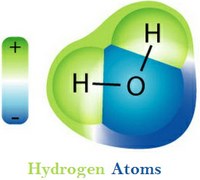
A possible way to discover new sources of CP violation is to search for the electric dipole moment of fundamental particles.
The Electric Dipole Moment (EDM) of a particle is determined by the separation of positive and negative charge distributions within the particle itself. In nature it is not rare to find systems with a non-null electric dipole moment.
For example, the water molecule is called “polar” because the centres of the positive and negative charge are separated . If we made the assumption that the water electric dipole moment was determined by the product of the electron charge and the size of the water molecule itself, we wouldn’t make a big mistake (~an order of magnitude).
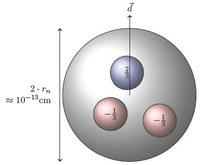
If we applied the same concept to a particle like the neutron instead, we would miss of at least 10 orders of magnitude! What is the reason?
The water ground state is degenerate: it is indeed the superimposition of states with opposite parity. The water molecule can have an electric dipole moment because it doesn’t violate any fundamental symmetry of nature. On the contrary, a fundamental particle (including neutron and proton) has a well defined parity state and cannot have an electric dipole moment because it would violate one of the nature fundamental symmetries: parity. This symmetry is conserved by three of the nature fundamental interactions. The electroweak force is the exception.
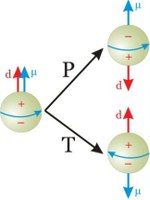
- The Electric Dipole Moment of fundamental particles and CP violation
The EDM of a particle has to be aligned with the particle spin (which is the only available quantisation axis). Such an alignment causes a violation of the P (parity) and T (time reversal) symmetries and, assuming that CPT is conserved, implies a violation of CP. The search for the electric dipole moment of fundamental particles is therefore search of new sources of CP violation.
- Experimental perpectives: measuring the Earth diameter with hairy-size accuracy
The Standard Model predicts that all fundamental particles have an EDM, but its theoretical predictions (neutron, $d_{n}\sim10^{-34}e \cdot cm$) are very far from the present experimental limits ($d_{n}\sim10^{-26}e \cdot cm$). Models beyond the Standard Model, on the other hand, make predictions within the experimental limits. The measure of a non-null electric dipole moment in present day or future experiments would be a clear proof of the existence of CP violation sources beyond the Standard Model.
Since the second half of last century, the search for an electric dipole moment has intensified and focused on neutrons, molecules and heavy atoms. For neutral systems, the basic idea is to apply an electric field $\vec{E}$ and measure the interaction energy $\vec{E}\cdot\vec{d}$ between the field and the electric dipole moment $\vec{d}$.
The recent developments in storage rings and polarised beams technology made possible a proposal of a direct measure of the electric dipolo moment of charged particles. The idea consists of storing a polarised beam in a storage ring and make it interact with a radial electric field. If the beam initial polarisation is aligned with the motion direction, the presence of a non-null electric dipole moment would be identified by the precession of the polarisation from the ring plane towards the vertical direction.
The Physics Department of the University of Ferrara started a series of dedicated studies in collaboration with German and American universities and research centres. In particular, feasibility studies are being performed at the COSY (COoler SYnchrotron) storage ring facility in Forschungszentrum Jülich (Germany). The final goal of the experiment is to measure the proton electric dipole moment within the limit of $d_{p}\sim10^{-29}e \cdot cm$.
In order to have an idea of such accuracy, let’s think about taking a proton (whose size is $1fm=10^{-15}m$) and extending it up to the Earth diameter. In such situation, an electric dipole moment as small as the one we want to measure, would correspond to a charge separation smaller then $10\mu m$ (hair diameter).
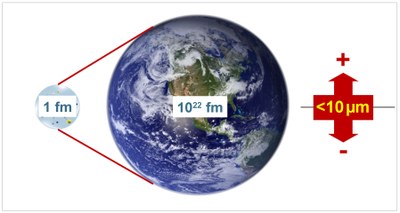
Responsible of the research:
Prof. Paolo Lenisa
e-mail:lenisa@fe.infn.it
tel.: 0532-974309
